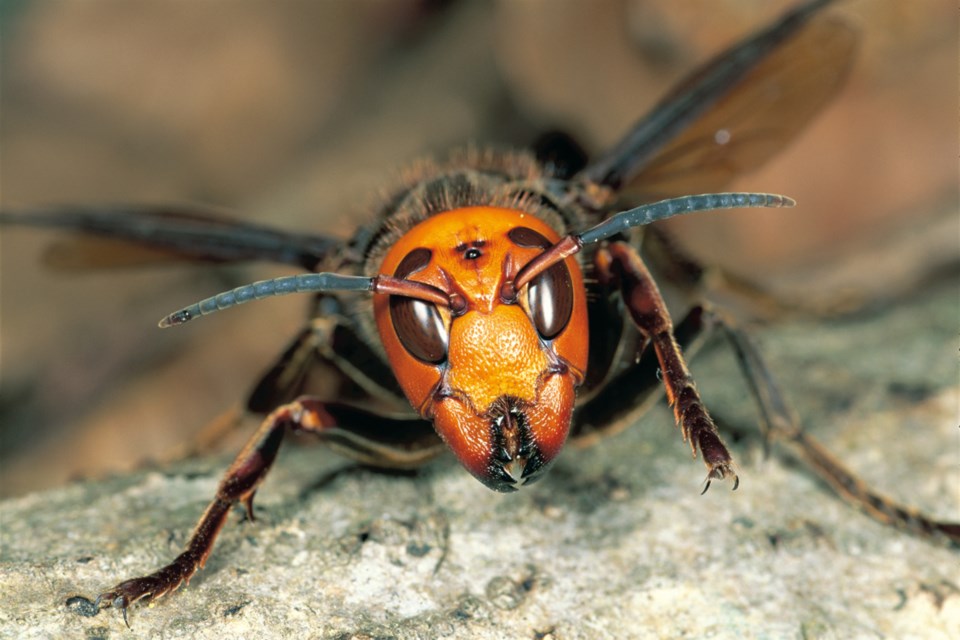As one of a handful of experts in North America with firsthand experience studying Asian giant hornets, also known as the 'murder hornet,' retired University of Guelph professor Gard Otis is uniquely positioned to understand the species’ recent arrival in the continent.
Sightings of the Asian giant hornet in Washington State and British Columbia last fall have raised concerns about the potential threat to honey bee populations, crops and humans from a species nicknamed “murder hornets.”
Otis is an expert in honeybee biology and insect ecology. He worked on various beekeeping projects in Vietnam over a period of seven years, including studying a “sister species” hornet in 2013.
“I don't think I could tell the difference between (the species) by looking at them,” he said. “I feel like I know this animal even though I haven't seen it (here).”
The Asian giant hornet is the world’s largest hornet. It typically lives in countries like Japan and China. Queens can grow up to two inches long, and are known for their massive wings, armoured bodies and toxic stinger. They are also known to decimate entire colonies of honey bees by decapitating them with spiked mandibles and then flying away with the thoraxes to feed their young.
Asian giant hornets don’t often attack humans, but in swarms, they have been known to kill a few dozen people a year in parts of Asia with their toxic venom and excruciating sting.
Otis says that while the introduction of this species to North America is concerning, it is not altogether surprising. He cites another Asian species - the yellow-legged hornet - that was introduced into Europe over 10 years ago.
“Despite all the efforts to contain it and to try to prevent it from increasing, it just keeps expanding its range,” he said. “So, we already knew that this was a possibility.”
Little is known about how the species actually made it into North America, but Otis says one likely explanation is that a single mated queen “hibernated” in a lumber shipment and then became active in its new environment in the spring.
“When we have an invasive insect that's been detected, we have a short period of time to try to contain it before it gets so abundant that the game is over,” he said. “So, since we only discovered them last fall, there's a hint that we might be able to stop them.”
But Otis is doubtful that enough can be done to stop the hornets entirely from expanding their presence. Rather, he says the focus should be on continued research about the species and its basic biology to inform appropriate action.
“It is not yet an established population. We don't know anything about how common they are, how genetically diverse they are. We don't know how this will play out,” he said. “State and provincial governments are going to try to get samples and there will be studies coming out. But in the early stages, we're going to be in destroy mode.”
Many experts, Otis included, resent the species’ ominous nickname. Dennis Schmidt is the president of the Wellington County Beekeepers’ Association, which provides outreach and education to beekeeping hobbyists in the area. He feels that the recent buzz in the media is somewhat sensationalized.
“It's interesting to see how much publicity [the hornet] is getting,” he said. “It does look a little bit like a villain from a superhero movie. It's very frightening in appearance and the size is really intimidating. But I don't think that we're going to see any practical concern on a local level.”
While the Asian giant hornet generally thrives in temperate climates, it remains to be seen whether it can also survive Canadian winters. But Schmidt says Ontario beekeepers are more concerned with other imported pests such as the hive beetle from the southern United States and killer bee genetics from California.
“With the number of bees that are shipped around the world, pests are now able to spread very quickly,” he said. “So far, we've been pretty lucky in Ontario … but I think that there is an impending fear that the current state of the industry is going to be shaken up.”
Still, if the Asian giant hornet does reach Ontario, Schmidt has faith in the province’s ability to deal with such a threat.
“There is a very well-established protocol that's overseen by the Ontario Ministry of Food, Agriculture and Rural Affairs (OMAFRA). We have a very strong and capable beekeeping association in Ontario (OBA) and they're very active in lobbying the government to control potential risks,” he said.
In the meantime, Otis has found himself being called upon as a valuable local source of expertise on this particular species. He says this underscores the importance of basic scientific research.
“Basic biology - that’s really my roots. A lot of the time, you can't predict when the research is going to have value ... just doing it sometimes is useful.”



